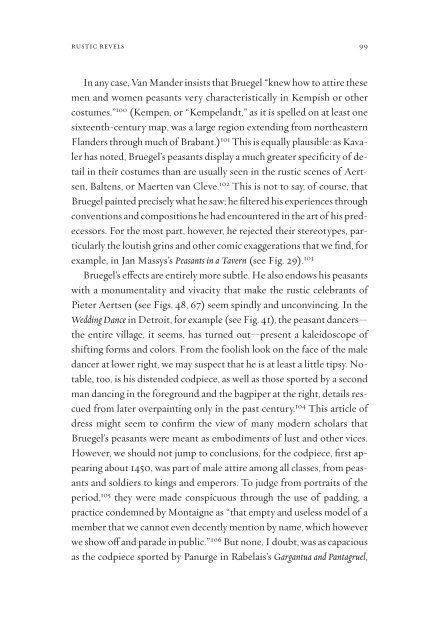Pieter Bruegel and the Art of Laughter - AAAARG.ORG
Pieter Bruegel and the Art of Laughter - AAAARG.ORG
Pieter Bruegel and the Art of Laughter - AAAARG.ORG
You also want an ePaper? Increase the reach of your titles
YUMPU automatically turns print PDFs into web optimized ePapers that Google loves.
ustic revels 99<br />
In any case, Van M<strong>and</strong>er insists that <strong>Bruegel</strong> “knew how to attire <strong>the</strong>se<br />
men <strong>and</strong> women peasants very characteristically in Kempish or o<strong>the</strong>r<br />
costumes.” 100 (Kempen, or “Kempel<strong>and</strong>t,” as it is spelled on at least one<br />
sixteenth-century map, was a large region extending from nor<strong>the</strong>astern<br />
Fl<strong>and</strong>ers through much <strong>of</strong> Brabant.) 101 This is equally plausible: as Kavaler<br />
has noted, <strong>Bruegel</strong>’s peasants display a much greater specificity <strong>of</strong> detail<br />
in <strong>the</strong>ir costumes than are usually seen in <strong>the</strong> rustic scenes <strong>of</strong> Aertsen,<br />
Baltens, or Maerten van Cleve. 102 This is not to say, <strong>of</strong> course, that<br />
<strong>Bruegel</strong> painted precisely what he saw; he filtered his experiences through<br />
conventions <strong>and</strong> compositions he had encountered in <strong>the</strong> art <strong>of</strong> his predecessors.<br />
For <strong>the</strong> most part, however, he rejected <strong>the</strong>ir stereotypes, particularly<br />
<strong>the</strong> loutish grins <strong>and</strong> o<strong>the</strong>r comic exaggerations that we find, for<br />
example, in Jan Massys’s Peasants in a Tavern (see Fig. 29). 103<br />
<strong>Bruegel</strong>’s eªects are entirely more subtle. He also endows his peasants<br />
with a monumentality <strong>and</strong> vivacity that make <strong>the</strong> rustic celebrants <strong>of</strong><br />
<strong>Pieter</strong> Aertsen (see Figs. 48, 67) seem spindly <strong>and</strong> unconvincing. In <strong>the</strong><br />
Wedding Dance in Detroit, for example (see Fig. 41), <strong>the</strong> peasant dancers—<br />
<strong>the</strong> entire village, it seems, has turned out—present a kaleidoscope <strong>of</strong><br />
shifting forms <strong>and</strong> colors. From <strong>the</strong> foolish look on <strong>the</strong> face <strong>of</strong> <strong>the</strong> male<br />
dancer at lower right, we may suspect that he is at least a little tipsy. Notable,<br />
too, is his distended codpiece, as well as those sported by a second<br />
man dancing in <strong>the</strong> foreground <strong>and</strong> <strong>the</strong> bagpiper at <strong>the</strong> right, details rescued<br />
from later overpainting only in <strong>the</strong> past century. 104 This article <strong>of</strong><br />
dress might seem to confirm <strong>the</strong> view <strong>of</strong> many modern scholars that<br />
<strong>Bruegel</strong>’s peasants were meant as embodiments <strong>of</strong> lust <strong>and</strong> o<strong>the</strong>r vices.<br />
However, we should not jump to conclusions, for <strong>the</strong> codpiece, first appearing<br />
about 1450, was part <strong>of</strong> male attire among all classes, from peasants<br />
<strong>and</strong> soldiers to kings <strong>and</strong> emperors. To judge from portraits <strong>of</strong> <strong>the</strong><br />
period, 105 <strong>the</strong>y were made conspicuous through <strong>the</strong> use <strong>of</strong> padding, a<br />
practice condemned by Montaigne as “that empty <strong>and</strong> useless model <strong>of</strong> a<br />
member that we cannot even decently mention by name, which however<br />
we show oª <strong>and</strong> parade in public.” 106 But none, I doubt, was as capacious<br />
as <strong>the</strong> codpiece sported by Panurge in Rabelais’s Gargantua <strong>and</strong> Pantagruel,












